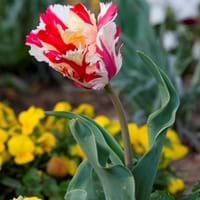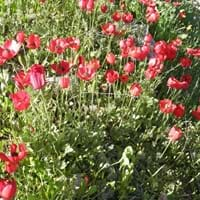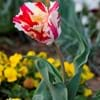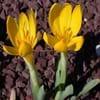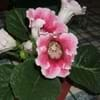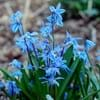Life Span
Annual and Perennial
Perennial
Type
Bulb or Corm or Tuber
Bulb or Corm or Tuber
Origin
Hybrid origin
Southern Europe, Mediterranean
Types
Not Available
Not Available
Habitat
Fertile bottom land, Loamy soils, Well Drained
damp meadows, Dry areas, Woodland edges
USDA Hardiness Zone
3-8
8-12
Habit
Clump-Forming
Upright/Erect
Flower Color
Light Yellow, Light Pink, Peach, Light Green, Dark Salmon
White, Red, Blue, Pink
Flower Color Modifier
Bicolor
Bicolor
Fruit Color
Green, Tan
Not Available
Leaf Color in Spring
Green
Green
Leaf Color in Summer
Light Green
Light Green
Leaf Color in Fall
Several shades of Green
Several shades of Green
Leaf Color in Winter
Light Green
Light Green
Leaf Shape
Lance shaped
Lobed
Plant Season
Spring
Spring, Winter
Sunlight
Full Sun, Partial Sun
Full Sun, Partial Sun, Partial shade
Type of Soil
Loam, Sand
Loam, Sand
The pH of Soil
Neutral
Acidic, Neutral, Alkaline
Soil Drainage
Well drained
Well drained
Bloom Time
Early Spring, Spring
Early Spring, Spring, Late Winter, Indeterminate
Tolerances
Drought
Drought
Where to Plant?
Bedding, Container, Ground
Ground, Pot
How to Plant?
Micropropagation, Offsets, Seedlings, Tissue culture
Seedlings, Tuber propagation
Plant Maintenance
Medium
Medium
Watering Requirements
Allow to dry out slightly between watering, Average Water Needs, Do not water from above
Medium
In Summer
Lots of watering
Lots of watering
In Spring
Moderate
Moderate
In Winter
Average Water
Average Water
Soil pH
Neutral
Acidic, Neutral, Alkaline
Soil Type
Loam, Sand
Loam, Sand
Soil Drainage Capacity
Well drained
Well drained
Sun Exposure
Full Sun, Partial Sun
Full Sun, Partial Sun, Partial shade
Pruning
Remove damaged leaves, Remove dead branches, Remove dead leaves
Remove damaged leaves, Remove dead branches, Remove dead leaves
Fertilizers
All-Purpose Liquid Fertilizer
All-Purpose Liquid Fertilizer
Pests and Diseases
Aphids, Red blotch, Tulip Viruses
Cutworms
Plant Tolerance
Drought
Drought
Flower Petal Number
Single, Semi-Double
Single, Double, Semi-Double
Foliage Texture
Medium
Fine
Foliage Sheen
Matte
Matte
Attracts
Bees, Butterflies
Butterflies, Hummingbirds, pollinators
Allergy
Nasal irritation, Skin irritation, Skin rash
Not Available
Aesthetic Uses
Mass in beds, Mixed Border, Showy Purposes
Borders, Cottage Garden
Beauty Benefits
Not Available
Not Available
Environmental Uses
Air purification
Air purification
Medicinal Uses
No Medicinal Use
Antitumor, Cramps
Part of Plant Used
Flowers
Flowers, Leaves
Other Uses
Basketary, Used for fragrance, Used for Landscaping
Unknown
Used As Indoor Plant
No
No
Used As Outdoor Plant
Yes
Yes
Garden Design
Bedding Plant, Container, Cutflower, Edging, Feature Plant, Foundation, Mixed Border
Bedding Plant, Container, Cutflower, Mixed Border, Rock Garden / Wall
Botanical Name
TULIPA 'Apricot Parrot'
ANEMONE coronaria
Common Name
Apricot Parrot Tulip, Parrot Tulip
Crown Windflower, Lilies-of-the-Field, Poppy-flowered Anemone, wind flower
In Hindi
Parrot Tulip
Poppy Flowered Anemone
In German
Papageientulpe
Kronen-Anemone
In French
Parrot Tulip
Anémone couronnée
In Spanish
Parrot Tulip
Poppy flowered Anemone
In Greek
παπαγάλος τουλίπα
Poppy Flowered Anemone
In Portuguese
Parrot Tulip
Poppy Flowered Anemone
In Polish
tulipany papuzie
Zawilec wieńcowy
In Latin
Parrot tulip
Poppy Flowered Anemone
Phylum
Ascomycota
Anthophyta
Class
Triumph
Equisetopsida
Family
Liliaceae
Ranunculaceae
Clade
Angiosperms
Angiosperms, Eudicots
Subfamily
NA
Not Available
Number of Species
Not Available
Importance of Parrot Tulip and Poppy Flowered Anemone
Want to have the most appropriate plant for your garden? You might want to know the importance of Parrot Tulip and Poppy Flowered Anemone. Basically, these two plants vary in many aspects. Compare Parrot Tulip and Poppy Flowered Anemone as they differ in many characteristics such as their life, care, benefits, facts, etc. Every gardener must at least have the slightest clue about the plants he wants to plant in his garden. Compare their benefits, which differ in many ways like facts and uses. The medicinal use of Parrot Tulip is No Medicinal Use whereas of Poppy Flowered Anemone is Antitumor and Cramps. Parrot Tulip has beauty benefits as follows: Not Available while Poppy Flowered Anemone has beauty benefits as follows: Not Available.
Compare Facts of Parrot Tulip vs Poppy Flowered Anemone
How to choose the best garden plant for your garden depending upon its facts? Here garden plant comparison will help you to solve this query. Compare the facts of Parrot Tulip vs Poppy Flowered Anemone and know which one to choose. As garden plants have benefits and other uses, allergy is also a major drawback of plants for some people. Allergic reactions of Parrot Tulip are Nasal irritation, Skin irritation and Skin rash whereas of Poppy Flowered Anemone have Not Available respectively. Having a fruit bearing plant in your garden can be a plus point of your garden. Parrot Tulip has no showy fruits and Poppy Flowered Anemone has no showy fruits. Also Parrot Tulip is not flowering and Poppy Flowered Anemone is not flowering . You can compare Parrot Tulip and Poppy Flowered Anemone facts and facts of other plants too.
